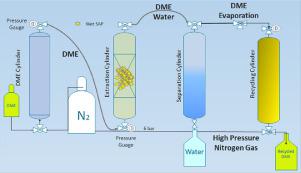Resources, Conservation and Recycling ( IF 13.2 ) Pub Date : 2021-05-19 , DOI: 10.1016/j.resconrec.2021.105641 Cheng Chi Wu , Srivatsan Raghavan , Alexandra Pine , Jose Alfaro , Brian J. Love , Dimitris I. Collias

|
The high saturation potential of highly hygroscopic desiccants makes their drying potential reuse an energetically unfavorable challenge. Perhaps there are other ways beyond dehydration the extract saturated water from these structures. That was the premise of the proposed experiments in which an existing method was redesigned in which condensed Dimethyl Ether (DME) was used aqueous fluids from commercial grade superabsorbent polymers (SAPs) similar to those found in commercial diapers. It was hypothesized that liquid extraction could be energetically less intensive than thermally dehydrating the SAP. By toggling between pressures above and below 0.6 MPa at room temperature, using gravity assistance, and nitrogen gas as driving forces, the DME condenses and interacts with the saturated SAP. The system successfully dewatered both DI water and saline saturated SAP. Roughly 90% of deionized water and ~80% of artificial urine are extractable from SAP when the chamber was pressurized 3 times. The salts in the artificial urine also conveyed in the aqueous extract and not concentrated in the dehydrated SAP. Energy assessments linked with each DME loading consumed 12.6 kJ or ~5 kJ/g of water extracted, more than required for thermal evaporation. The dehydrated superabsorbent polymer structure appears morphologically different by microscopy, but it can re-swell up to 35 times its dry mass in water and 15 times its mass in artificial urine. Overall, aqueous phase extraction using condensed DME dewaters saturated superabsorbent polymers allowing their reuse as other forms of desiccants but it is less efficient than by dehydration.
中文翻译:

高吸收性聚合物的脱水:使用二甲醚进行液相萃取进行热脱附的替代方法
高吸湿性干燥剂的高饱和势能使它们的干燥势能再利用在能源上是不利的挑战。也许除了脱水以外,还有其他方法可以从这些结构中提取饱和水。这是提出的实验的前提,在该实验中,重新设计了一种现有方法,其中使用了与商业尿布中相似的,来自商业级超吸收性聚合物(SAPs)的冷凝二甲醚(DME)的水性流体。据推测,与热脱水SAP相比,液体提取在能量上的消耗可能较小。通过使用重力辅助和氮气作为驱动力,在室温下在高于和低于0.6 MPa的压力之间切换,DME会冷凝并与饱和SAP相互作用。该系统成功地将去离子水和盐水饱和的SAP脱水。当腔室加压3次后,大约90%的去离子水和约80%的人造尿液可从SAP中提取。人造尿液中的盐也可以在含水提取物中输送,而不能在脱水的SAP中浓缩。与每个DME负载相关的能量评估消耗了12.6 kJ或〜5 kJ / g提取的水,超过了热蒸发所需的能量。脱水的超吸收性聚合物的结构在显微镜下看起来在形态上有所不同,但是在水中它可以重新膨胀至干质量的35倍,在人造尿液中膨胀至15倍。总体而言,使用缩合DME进行水相萃取会使饱和的超吸收性聚合物脱水,从而使它们可重复用作其他形式的干燥剂,但效率不及脱水效果。



























 京公网安备 11010802027423号
京公网安备 11010802027423号